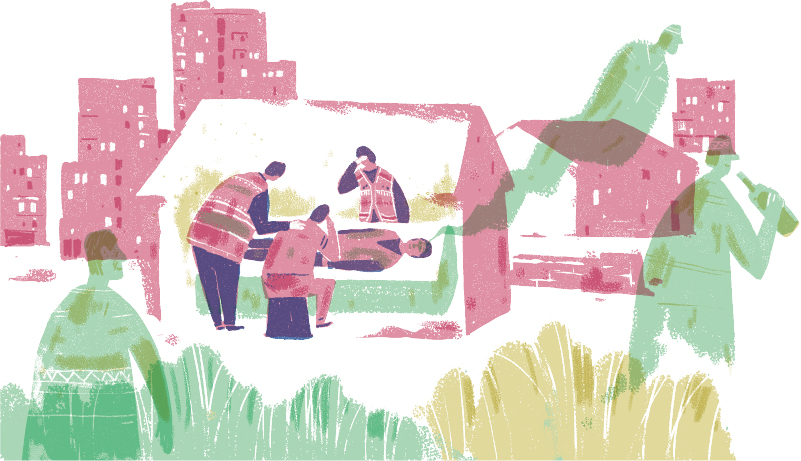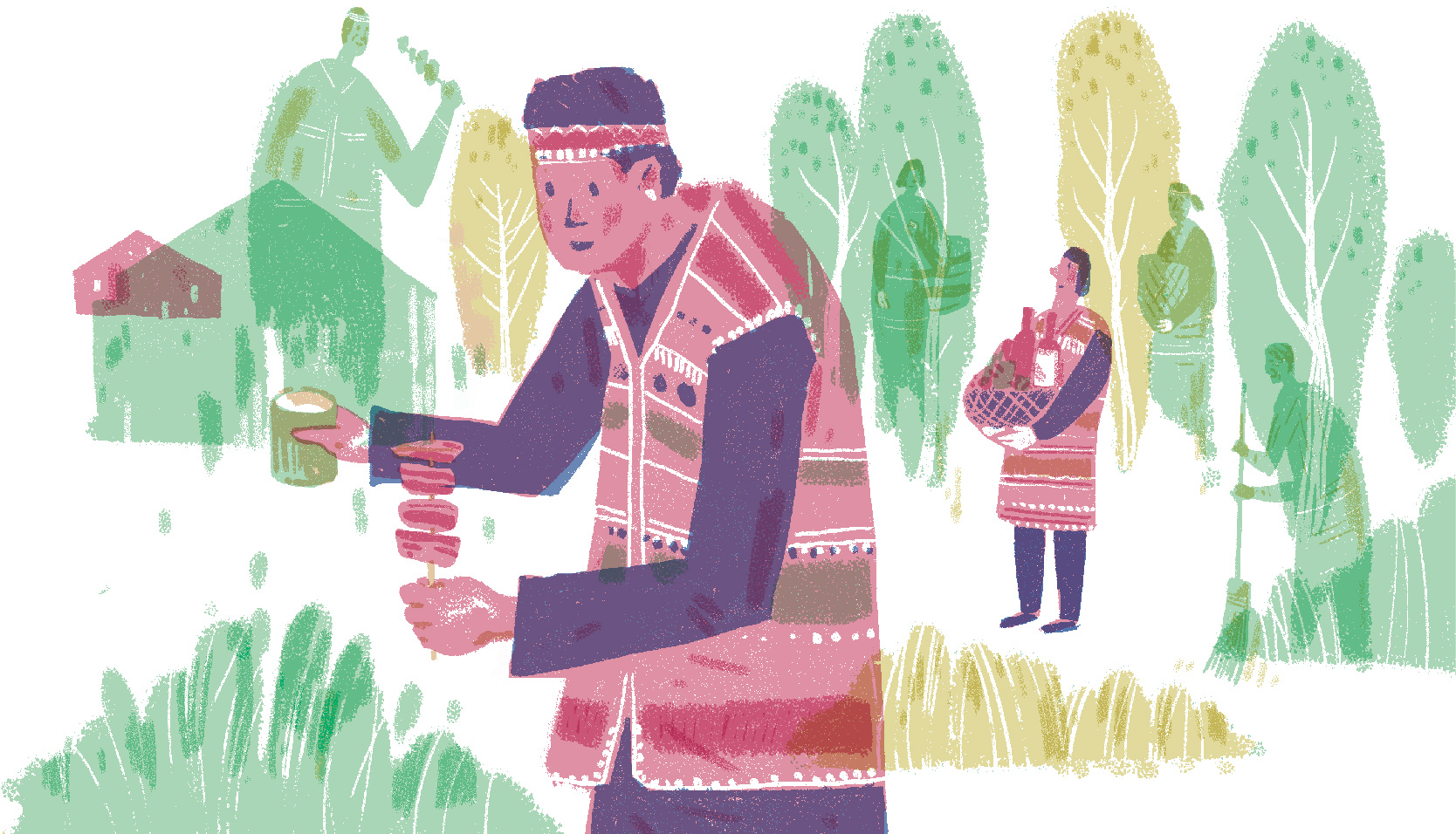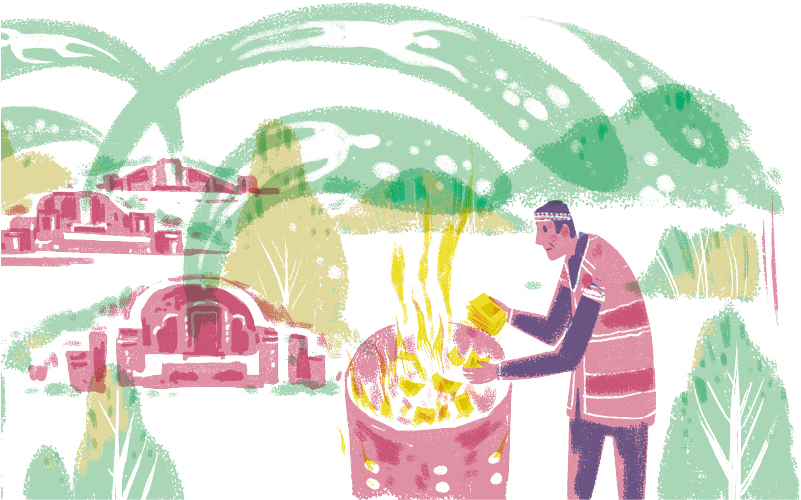Amid the November evening breeze, at Nanzhuang Township’s Raremewan, Miaoli County, a low and solemn sacrificial song is heard. Accompanied by the rhythm of “Tabaa'sang”, a traditional kind of SaySiyat musical instrument, the song raises the curtain on the biennial paSta'ay (Dwarf spiritual sacrifice) that unique to Taiwan’s indigenous SaySiyat people. Nanzhuang Township is known as the hometown of the SaySiyat people. But almost every resident here speaks Hakka. They also follow the non-indigenous Hakka customs such as making offerings to Earth Lord “Old Uncle,” worshiping ancestral tablets at home, and even hanging strips of paper on the headstones when sweeping their ancestral tombs. How do the SaySiyat people, who once featured an indigenous culture of revering the Nature, respecting the “ta'ay” with awe, and worshipping ancestral spirits in traditional ways, come to meet and interact with Hakka culture, and in turn change their original values of faith?


Like many of their counterparts around the world, the indigenous peoples in Taiwan believe that everything in heaven and earth is dominated by a mighty supernatural power beyond the control of human beings. This notion gives rise to their worship of nature, in which people believe that they will be bestowed with blessings and happiness when they show great respect for the dominators of various natural powers.
The SaySiyat believe that between a living person’s head and chest hides “’azem” (soul), which is considered the hub that governs one’s thinking. When an infant is born, with its skull bones remaining open, the brain beats with the pulse, therefore marking the existence of its soul. When one dies, his/her ‘azem becomes “habon” (spirit), with the distinction between male and female as well as good and evil. The spirits of the deceased will not disappear but instead are linger around those left behind. On special days and occasions, ancestral spirits will return to reunite with their descendants.
What the SaySiyat is most famous for is its belief in the spirit of ta’ay, which originates from the legend of ta’ay who are said to have lived side-by-side with the community. Legend has it that it was these dwarves who had taught the SaySiyat people arts of farming. But they were entrapped and exterminated by their SaySiyat neighbors in the end. To express their gratitude intertwined with guiltiness and fear, the SaySiyat make it a custom to hold a series of rituals known as “paSta’ay” to comfort the spirits of ta’ay. Based on their belief, the “habon” of ta’ay will return to the village during the rituals. Therefore, there are various taboos to be avoided lest punishments be imposed by these spirits.
In addition to the well-known “paSta’ay,” the SaySiyat people also hold other various traditional rituals that have been passed down for generations, such as “pasbaki”(ancestral ritual), “oe’oewaz”(weather-praying ritual), and “pat-aza” (sawing ritual). All the community members take these rituals very seriously. Every year, they make it a point to return home to participate, even the younger generation is no exception.


The worship of deities, ancestors, as well as ghosts and spirits constitute the core of Hakka religious beliefs. The Hakkas traditionally believe that when elders pass away, their spirits will “be elevated to gods” or “return to the ranks of immortals.” Hence, they make it a custom to worship ancestors, who are constantly being “deified.” The immortalized ancestors are considered to have a mysterious power that enables them to watch the behavior of their descendants from time to time and provide blessings for peace and safety to each household. The Hakka ancestral worshipping is termed as “making offerings to Grandpa and Grandma,” which is held on seasonal festivals and major life events, such as births, marriages, and deaths.
Apart from worshipping ancestors, there is a tomb sweeping activity called “paper hanging,” which takes place on a specific date of the year. At the end of it, strips of paper are hung on the headstone to mark the completion of the task. Chungyuan Festival (the Ghost Festival), which falls on the fifteenth day of the seventh month of the lunar calendar, is a major event in the Hakka tradition. On the evening of this day, the “pudu” ceremony is held by every household at the doorstep of their homes, where sacrifices and foods are offered to wandering ghosts, or “good brothers.”


A Mix of SaySiyat
and Hakka Cultures
The traditional worldview of the SaySiyat people is a dichotomous one featuring the mundane world of living creatures against the spiritual world alone, which forms a sharp contrast to that of the Hakka’s emphasizing the coexistence of human beings, ghosts, and deities. However, since the 17th century, the lifestyles and living habits of Taiwan’s indigenous peoples have been affected by the rule of many foreign regimes starting from the Ming-Zheng period. Take Nanzhuang, which was at first resided by the SaySiyat, for example. In the early days, the booming camphor industry attracted large numbers of Hakka people to move in, resulting in the contact between the two ethnic groups. In the late Qing Dynasty, although boundaries were made to prevent physical contact between Non-indigenous Chinese and the SaySiyat, the interaction of both sides had nonetheless never been deterred. Over time, it turns out that the SaySiyat have adopted the Hakka custom of worshipping ancestors, deities, and ghosts, and further incorporated some Hakka practices into their own beliefs, bringing a different appearance to their religious culture.
The SaySiyat call their elders are “tatini.” With reverence for their ancestral spirits, the SaySiyat believe that after the death of tatini, their souls will live on in the spiritual world, remaining in the communities to watch over their descendants. Despite such belief in spirits, however, in the past they did not seek to materialize the existence of unseen tatini, nor did they ever think of making a home for them.
Over time, thanks to the frequent contact with the Hakka community, the SaySiyat gradually come to appreciate the advantages of worshipping ancestors. The SaySiyat people are then motivated to reflect on the way they treat their ancestors. Instead of following the tradition of burying the dead in the house, they begin to set up ancestral tablets at home and build graves for the ancestors. The existence of invisible ancestral spirits is thus manifested physically and symbolized in the forms of tablet and graveyard. Following the Hakka religious custom, the SaySiyat also “care for” their tatini by offering food regularly.
The Importance of Caring for tatini, Alive or Dead
The Hakkas usually refer to the act of worshipping ancestors as “serving,” “revering,” or “making offerings to” grandpas and grandmas. In the SaySiyat’s rendering, however, such practice is called “pasi'aelen,” which means “feeding tatini.” This is because they believe that their tatini are still living with them even after death. Hence, they make it a point to treat their spirits in the same way they care for elders by offering food.
Besides, the SaySiyat community typically comprises different clans, each of which has equal status. As each clan’s individual households begin to worship their tatini to pray for peace and prosperity by setting up ancestral tablets, the influence of Hakka religious belief on the SaySiyat is manifested. This indicates that the SaySiyat people are placing more emphasis on the personalized needs of individuals and their families. As a resident of Penglai Village in Nanzhuang tells us, although they were not of the habit of doing feng shui, now they pay particular attention to it and apply the principles to the placement of their immortalized tatini. They are also convinced that worshipping tatini at home may not only bring blessings to family members who are not doing well but also resolve difficulties of the family.

Innovative Transformation of SaySiyat Beliefs
Through Cross-cultural Mingling
❝
If Tatini did not kill anyone when he/she was alive, he/she will be incarnated after death.
❞
“After being exposed to the Non-indigenous Chinese, many of our ideas have been influenced. Take the Longshen (Wu Fu) Temple, a shrine dedicated to the SaySiyat’s legendary baki’ Soro (a heavenly giant snake). They manage it in the same way as Hakkas do by gathering a mix of different deities, from the Gold Boy and Jade Girl, as well as the Jade Emperor of Taoism, even to whatever gods of the SaySiyat mythology—you name it. I do admire this idea, though I don’t agree with it. Yet I still show my respect by offering support occasionally,” recalls a member of the Sawan Clan from Penglai Village.
It is only now that the traditional beliefs of every indigenous group are on the decline. However, if we study it carefully, we will find that the details of the present-day SaySiyat paSta’ay, including related ceremonies and taboos, remain nearly unchanged. The “oe’oewaz,” which is way more mysterious than paSta’ay and has more taboos to abide by, still allows no foreigners to participate. In some cases, even people from the same community but under different surnames are excluded from some of the rituals. As can be seen from these regulations, the SaySiyat people’s adherence to their traditional rites and rituals allows no room for compromise in the face of social change and the greater environment.
Over time, with constant exposure to Hakka culture, the SaySiyat have learned to incorporate the Hakka religious beliefs and practices into their own culture. They not only adhere to their traditional beliefs but at the same time adopt the foreign concepts of Hakka deities. Such fusion has resulted in the creation of a new SaySiyat- Hakka culture unique to the contemporary SaySiyat communities in Nanzhuang area.

References:
王美晶譯(1999)| 臺灣原住民風俗。臺北市:原民文化。原書:鈴木質(1945)。臺灣蕃人風俗誌。臺北市:理蕃の友。
林修澈(2000)| 臺灣原住民史賽夏族史篇。南投市:省文獻會。
林道生(2003)| 原住民神話與文化賞析。臺北縣中和市:威穎國際公司總經銷。
徐清明(2007)| 重修苗栗縣志。苗栗市:苗栗縣政府。
張致遠(1997)| 賽夏文化彙編:傳統與變遷。苗栗市:苗栗縣立文化中心。
潘秋榮(2000)| 小米貝珠雷女:賽夏族祈天祭。臺北縣:臺北縣文化局。




